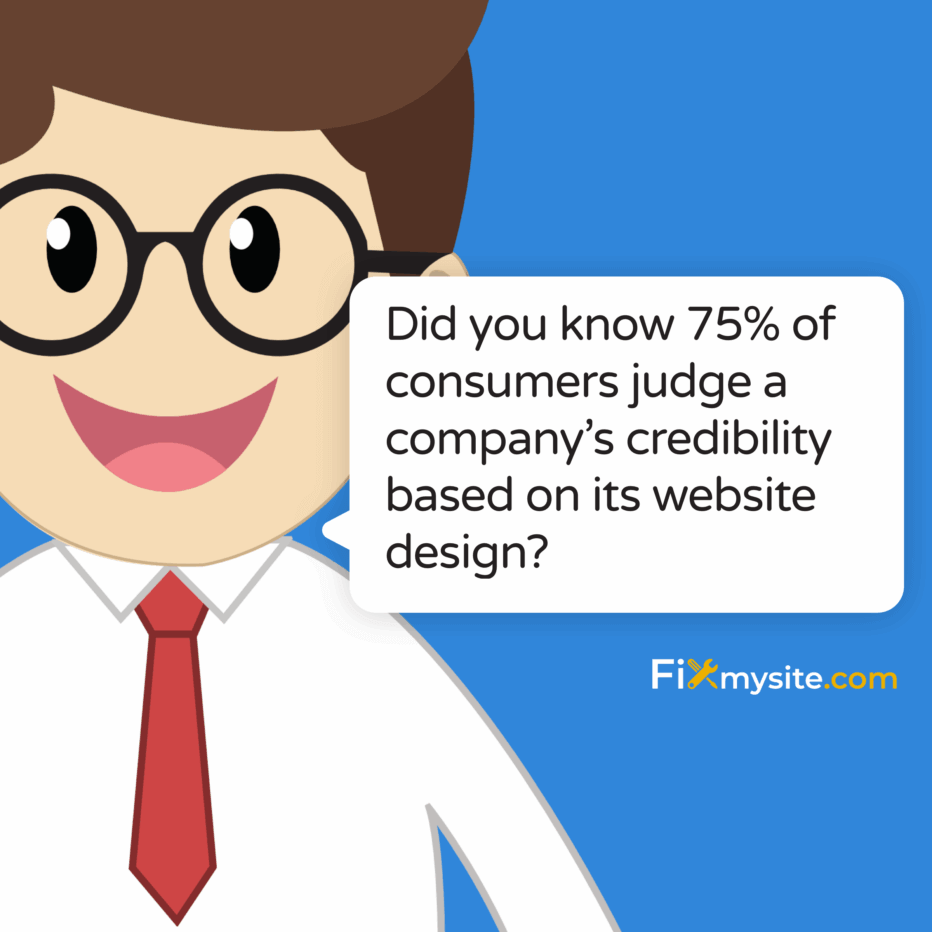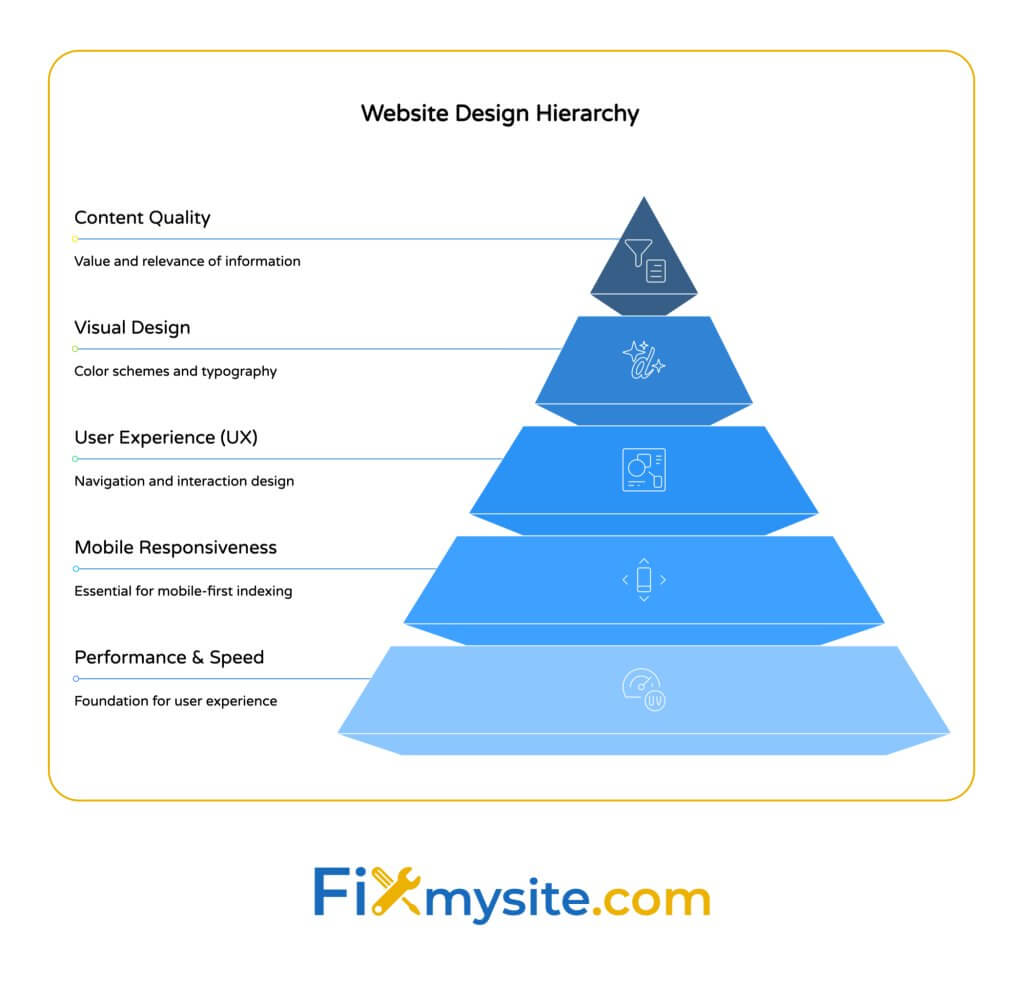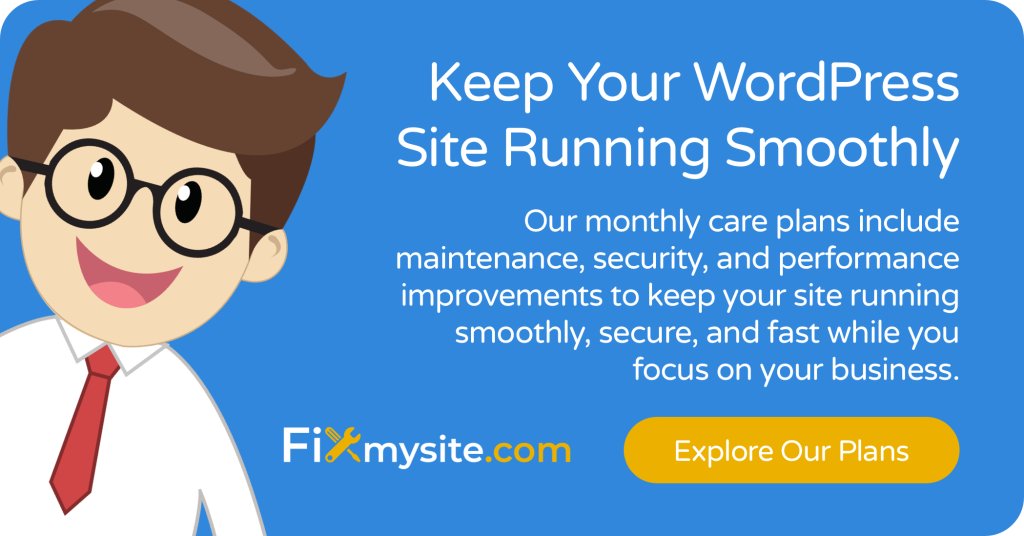
Your website serves as your digital storefront. It shapes how potential customers perceive your business and influences their decision to engage with your services. When visitors land on your page, they form judgments almost instantly—before even reading a single word.
Did you know that 75% of consumers judge a company’s credibility based on website design? (Source: Business Dasher) With such high stakes, identifying the most crucial element of website design becomes essential for business success.
As WordPress website owners and managers navigate design decisions, a common question emerges: which design element deserves the highest priority? This guide will explore the key components of effective website design, examine their relative importance, and help you make informed decisions about where to focus your efforts.
The Impact of Website Design on Business Success

Website design isn’t merely about aesthetics—it directly affects your bottom line. Research shows that 94% of first impressions are design-related, meaning visitors judge your site based on visual appeal before evaluating your content or services. (Source: Business Dasher)
For small businesses, having a well-designed website is no longer optional. Currently, 71% of small businesses have a website, and those with websites grow twice as fast as those without. (Source: Business Dasher)
When visitors trust your website, they’re more likely to trust your business. Nearly half (48%) of users consider website design the primary indicator of business credibility. (Source: Business Dasher) This means your design choices directly influence whether potential customers view your business as legitimate and professional.
| Website Design Element | Impact on User Perception | Business Outcome |
|---|---|---|
| Visual Appeal | First Impression Formation | Increased Trust and Engagement |
| Navigation Structure | Ease of Finding Information | Longer Site Sessions and Return Visits |
| Page Speed | Perception of Efficiency | Reduced Bounce Rate and More Conversions |
| Mobile Responsiveness | Accessibility and Convenience | Wider Audience Reach and Engagement |
As the table illustrates, different design elements affect user perception in unique ways. Each element leads to various business outcomes. Understanding these relationships helps prioritize design decisions based on your specific business goals.
Key Elements of Successful Website Design
Before we determine which element is most important, let’s examine the essential components that contribute to successful website design. Each element plays a specific role in creating a cohesive, effective online presence.
Website design encompasses multiple disciplines and considerations. From visual aesthetics to technical performance, each component contributes to the overall user experience. The challenge lies in determining which element deserves the highest priority when resources or time are limited.
While some design elements are immediately visible, others work behind the scenes to enhance user experience. Both visible and invisible elements must work together to create a website that attracts, engages, and converts visitors.

User Experience (UX) Design
User experience encompasses how people interact with your website. Good UX design creates intuitive, frictionless interactions that help visitors accomplish their goals easily. It focuses on the journey users take through your site and works to remove obstacles.
Effective UX design begins with understanding your users’ needs and expectations. What are they trying to accomplish on your site? What information are they seeking? How can you make their journey smoother? Answering these questions helps create user-centered design that serves both visitors and business goals.
- Navigation structure: Clear, logical site organization that helps users find information quickly
- Information architecture: Thoughtful content organization that supports user decision-making
- Interaction design: Intuitive buttons, forms, and interactive elements that respond predictably
- Accessibility: Design features that make your site usable by people with various abilities and disabilities
When UX design succeeds, users can accomplish their goals without frustration. They can easily find what they’re looking for, complete desired actions, and leave with a positive impression of your brand. Poor UX creates friction that drives visitors away—often to your competitors.
Visual Design and Aesthetics
Visual design creates the first impression visitors have of your website. It encompasses color schemes, typography, imagery, and the overall visual hierarchy of your pages. Effective visual design aligns with your brand identity while creating an engaging, professional appearance.
Color psychology plays a significant role in how users perceive your website. Different colors evoke specific emotions and associations. For example, blue often conveys trust and reliability, while red can signal urgency or excitement. Your color choices should reflect your brand personality and appeal to your target audience.
Typography affects both readability and brand perception. Font choices should balance aesthetic appeal with practical considerations like legibility across devices. Most effective websites use a limited font palette—typically 2-3 complementary fonts—to maintain visual consistency while creating clear information hierarchy.
| Visual Element | Role in Design | Best Practices |
|---|---|---|
| Color Scheme | Sets emotional tone and reinforces brand identity | Use 2-3 primary colors with complementary accents; ensure sufficient contrast for readability |
| Typography | Affects readability and information hierarchy | Limit to 2-3 fonts; use consistent sizing; ensure readability on all devices |
| Imagery | Communicates concepts visually; adds emotional appeal | Use high-quality, relevant images; optimize file sizes; include alternative text |
| White Space | Creates visual breathing room; highlights important elements | Don’t overcrowd pages; use strategic spacing to guide the eye |
Visual design elements work together to create an overall aesthetic that either attracts or repels visitors. A cohesive, professional visual design builds trust and keeps visitors engaged with your content.
Website Performance and Speed
Speed matters more than most site owners realize. The average website load time is 3.21 seconds, yet research shows users often abandon sites that take longer than 3 seconds to load. (Source: Business Dasher)
Site speed affects not only user experience but also search engine rankings. Search engines like Google factor load time into their ranking algorithms. This means slower sites may appear lower in search results. Poor performance creates a double penalty: fewer visitors find your site, and those who do are more likely to leave without taking action.
Several technical factors influence website speed, including server response time, image optimization, code efficiency, and caching implementation. Addressing these elements requires technical knowledge, but the performance improvements often justify the investment.
- Image optimization: Compress images without sacrificing quality; use appropriate file formats
- Caching: Implement browser and server caching to reduce load times for returning visitors
- Code minification: Remove unnecessary characters from HTML, CSS, and JavaScript files
- Content Delivery Networks (CDNs): Distribute your content across multiple geographic locations for faster delivery
For WordPress sites specifically, WordPress speed optimization techniques can dramatically improve performance without requiring extensive technical knowledge. Simple steps like installing a caching plugin, optimizing images, and cleaning your database can yield significant speed improvements.
Mobile Responsiveness
The importance of mobile-friendly design cannot be overstated. Currently, 67.56% of website traffic comes from mobile devices. (Source: Business Dasher) This means for most websites, the majority of visitors are viewing content on smartphones or tablets rather than desktop computers.
Mobile responsiveness ensures your website functions properly and looks good on screens of all sizes. A responsive design automatically adjusts layout, image sizes, and interactive elements based on the device being used. This creates a consistent, user-friendly experience across devices.
Beyond user experience, research shows that mobile optimization significantly impacts search rankings. Google has implemented mobile-first indexing, meaning it primarily uses the mobile version of a site for ranking and indexing. Sites that perform poorly on mobile devices typically rank lower in search results, regardless of their desktop performance.
| Mobile Design Consideration | Desktop Approach | Mobile Approach |
|---|---|---|
| Navigation | Full menu visible; multiple dropdown options | Hamburger menu; simplified options; touch-friendly targets |
| Content Layout | Multi-column designs; horizontal orientation | Single-column layout; vertical scrolling orientation |
| Image Display | Larger images; multiple visible simultaneously | Scaled images; fewer visible at once; optimized for data usage |
| Input Methods | Designed for keyboard and mouse | Optimized for touch; larger buttons; simplified forms |
Implementing mobile-responsive design requires understanding how users interact with mobile devices differently than desktop computers. Touch interfaces, smaller screens, and variable connection speeds all influence how your site should function on mobile devices.
Content Quality and Structure
Even the most visually stunning website will fail if its content doesn’t meet user needs. Content quality encompasses the value, relevance, and presentation of your website’s information. High-quality content answers visitor questions, solves their problems, and guides them toward taking desired actions.
Content structure refers to how information is organized and presented. This includes headings, paragraphs, lists, and other formatting elements that make content scannable and digestible. Good content structure helps visitors quickly find the information they seek without reading every word on the page.
Visual hierarchy guides visitors’ attention through your content in order of importance. Using size, color, contrast, and spacing, you can emphasize certain elements while de-emphasizing others. This creates clear pathways for visitors to follow and helps them absorb information in a logical sequence.
- Scannable formatting: Use headings, short paragraphs, bullet points, and white space to make content easy to scan
- Clear, concise writing: Eliminate unnecessary words; use simple language; focus on benefits to the reader
- Purposeful imagery: Include images that enhance understanding, not just for decoration
- Strategic calls to action: Guide users toward next steps with clear, compelling action prompts
Content and design must work together harmoniously. The best design can’t compensate for poor content, and exceptional content can be undermined by poor presentation. Both elements must support each other to create an effective website.

Which Element Is Most Important? A Data-Driven Answer
After examining each critical website design element, we arrive at the central question: which is most important? The answer may not be what you expect.
The data suggests that website performance and speed have emerged as the most critical design element. Why? Because speed affects everything else. A slow-loading site undermines user experience, reduces engagement with your visual design, limits mobile usability, and prevents visitors from accessing your content.
Consider these interconnected relationships:
| If This Element Fails | These Elements Are Negatively Impacted | Resulting User Behavior |
|---|---|---|
| Performance/Speed | UX, Visual Design, Content Effectiveness, Mobile Experience | Abandonment before experiencing any other element |
| Mobile Responsiveness | UX, Visual Design, Content Accessibility | Frustration and abandonment for mobile users (majority of traffic) |
| User Experience | Content Effectiveness, Conversion Potential | Difficulty completing tasks despite good visuals and content |
| Visual Design | Perceived Credibility, Brand Perception | Reduced trust despite good functionality |
| Content Quality | Conversion Potential, SEO Performance | Failure to convert despite good design and functionality |
This analysis reveals a hierarchy of needs for website design. Performance serves as the foundation—if your site doesn’t load quickly, other design elements become irrelevant because users never experience them. Once performance is addressed, mobile responsiveness becomes critical due to the predominance of mobile traffic.
WordPress-Specific Design Considerations
For the 43% of websites that use WordPress as their content management system, specific design considerations apply. (Source: Bluehost) WordPress offers unique advantages and challenges for website design that affect which elements you should prioritize.
Theme selection forms the foundation of WordPress design. Your theme determines the overall structure, layout options, and many visual elements of your site. While thousands of themes are available, choosing one that balances aesthetics, functionality, and performance is essential for long-term success.
Plugin selection also significantly impacts WordPress site design. Plugins add functionality but can affect performance if not carefully chosen and maintained. Each plugin adds code to your site that must be loaded, potentially increasing load times and creating compatibility issues.
How do you optimize your WordPress site for speed while maintaining design quality? Balance is key. Start with a lightweight, well-coded theme. Then add only the plugins you truly need, prioritizing those from reputable developers with regular updates and good performance ratings.
WordPress maintenance plays a crucial role in sustained design effectiveness. Over time, themes and plugins require updates, databases accumulate unnecessary data, and content organization may need restructuring. Regular WordPress maintenance preserves both the visual appeal and functional performance of your site.
Common Website Design Mistakes to Avoid
Understanding what not to do can be as valuable as knowing what to prioritize. Many websites suffer from common design mistakes that undermine otherwise quality work. Recognizing and avoiding these pitfalls can significantly improve your site’s effectiveness.
One prevalent mistake is prioritizing flashy visual elements over functionality. While animations, sliders, and complex graphics might seem impressive, they often slow down your site and distract from its core purpose. Prioritize purposeful design that supports user goals rather than showcases technical capabilities.
| Common Mistake | Impact on Website | Better Alternative |
|---|---|---|
| Cluttered, busy layouts | Cognitive overload; confusion about priorities | Clean design with clear visual hierarchy and adequate white space |
| Poor contrast between text and background | Readability issues; accessibility problems | High contrast color combinations that meet WCAG standards |
| Non-responsive design | Poor mobile experience; lower search rankings | Mobile-first responsive design that adapts to all screen sizes |
| Slow-loading pages | High bounce rates; reduced conversions | Optimized images and code; efficient hosting; proper caching |
| Generic stock photography | Reduced authenticity; forgettable impression | Original photography or high-quality, relevant stock images |
Another common error is neglecting regular testing across different devices and browsers. What works perfectly on your development setup might break on certain browsers or look distorted on specific devices. Implement regular cross-device and cross-browser testing to ensure consistent experiences for all users.
Many site owners also make the mistake of designing for themselves rather than their users. Your personal preferences matter less than what works for your target audience. Base design decisions on user research, analytics, and testing rather than subjective opinions.
How to Implement Effective Website Design
Now that we’ve identified website performance as the most critical design element, how do you implement this knowledge? Let’s create a practical approach to website design that prioritizes the right elements in the right order.
Start by establishing performance benchmarks. Test your current site speed using tools like Google PageSpeed Insights or GTmetrix. Identify specific performance issues and create a plan to address them. Prioritize high-impact optimizations like image compression, caching implementation, and code minification.
Once performance meets acceptable standards, focus on mobile responsiveness. Test your site on various devices and screen sizes to identify and fix any responsive design issues. Pay special attention to navigation, form functionality, and content readability on smaller screens.
- Establish baseline metrics: Measure current performance, user behavior, and conversion rates
- Prioritize performance improvements: Address speed issues before making aesthetic changes
- Verify mobile functionality: Test thoroughly on multiple devices and screen sizes
- Refine user experience: Simplify navigation and user paths to important actions
- Enhance visual design: Update aesthetics to align with brand and support content hierarchy
Throughout the implementation process, continue testing with real users. Collect feedback, analyze user behavior data, and make iterative improvements. Website design is not a one-time project but an ongoing process of refinement based on performance data and user feedback.

Performance Forms the Foundation
After examining all the critical elements of website design, we can conclude that website performance—particularly speed—emerges as the most important factor for success. Without adequate performance, all other design elements become irrelevant as users abandon slow-loading sites before experiencing your content, visuals, or functionality.
This doesn’t diminish the importance of other design elements. Rather, it establishes a hierarchy of needs where performance creates the foundation upon which other elements can succeed. Once performance is optimized, mobile responsiveness, user experience, visual design, and content quality all play crucial roles in creating an effective website.
For WordPress site owners, prioritizing performance often means making careful decisions about themes, plugins, hosting, and maintenance. These technical considerations directly impact how users experience every other aspect of your design.
Need help optimizing your WordPress site’s performance? Our team at Fixmysite.com specializes in WordPress speed optimization, mobile responsiveness improvements, and overall site performance enhancement. Contact our support team to learn how we can help make your website more effective by prioritizing the elements that matter most.



